|
1
|
Buoso E, Masi M, Racchi M and Corsini E:
Endocrine-Disrupting Chemicals' (EDCs) effects on tumour
microenvironment and cancer progression: Emerging contribution of
RACK1. Int J Mol Sci. 21(9229)2020.PubMed/NCBI View Article : Google Scholar
|
|
2
|
González-Davis O, Chauhan K, Zapian-Merino
SJ and Vazquez-Duhalt R: Bi-enzymatic virus-like bionanoreactors
for the transformation of endocrine disruptor compounds. Int J Biol
Macromol. 146:415–421. 2020.PubMed/NCBI View Article : Google Scholar
|
|
3
|
Pellerin E, Caneparo C, Chabaud S, Bolduc
S and Pelletier M: Endocrine-disrupting effects of bisphenols on
urological cancers. Environ Res. 195(110485)2021.PubMed/NCBI View Article : Google Scholar
|
|
4
|
Leso V, Fontana L, Marinaccio A, Leopold
K, Fanali C, Lucchetti D, Sgambato A and Iavicoli I: Sub-chronic
palladium nanoparticle effects on the endocrine reproductive system
of female Wistar rats: Preliminary data. Toxicol Ind Health.
35:403–409. 2019.PubMed/NCBI View Article : Google Scholar
|
|
5
|
Jaffrezic-Renault N, Kou J, Tan D and Guo
Z: New trends in the electrochemical detection of endocrine
disruptors in complex media. Anal Bioanal Chem. 412:5913–5923.
2020.PubMed/NCBI View Article : Google Scholar
|
|
6
|
American Diabetes Association.
Classification and Diagnosis of Diabetes: Standards of medical care
in diabetes-2020. Diabetes Care. 43 (Suppl 1):S14–S31.
2020.PubMed/NCBI View Article : Google Scholar
|
|
7
|
Radu L, Carsote M, Gheorghisan-Galateanu
AA, Preda SA, Calborean V, Stanescu R, Gheorman V and Albulescu DM:
Blood parathyrin and mineral metabolism dinamics: A clinical
analyze. Rev Chim. 69:2754–2758. 2018.
|
|
8
|
Zimmet PZ: Diabetes and its drivers: The
largest epidemic in human history? Clin Diabetes Endocrinol.
3(1)2017.PubMed/NCBI View Article : Google Scholar
|
|
9
|
Zheng Y, Ley SH and Hu FB: Global
aetiology and epidemiology of type 2 diabetes mellitus and its
complications. Nat Rev Endocrinol. 14:88–98. 2018.PubMed/NCBI View Article : Google Scholar
|
|
10
|
Vann R, Bussuan RM, Rombaldi RL and Arbex
AK: Endocrine disruptors and the induction of insulin resistance.
Curr Diabetes Rev. 17(e102220187107)2021.PubMed/NCBI View Article : Google Scholar
|
|
11
|
Bai Q, Han K, Dong K, Zheng C, Zhang Y,
Long Q and Lu T: Potential applications of nanomaterials and
technology for diabetic wound healing. Int J Nanomedicine.
15:9717–9743. 2020.PubMed/NCBI View Article : Google Scholar
|
|
12
|
Kaur P and Khatik G: An overview of
computer-aided drug design tools and recent applications in
designing of antidiabetic agents. Curr Drug Targets. 22:1158–1182.
2021.PubMed/NCBI View Article : Google Scholar
|
|
13
|
Al-Quraishy S, Dkhil MA and Abdel Moneim
AE: Anti-hyperglycemic activity of selenium nanoparticles in
streptozotocin-induced diabetic rats. Int J Nanomedicine.
10:6741–6756. 2015.PubMed/NCBI View Article : Google Scholar
|
|
14
|
Khurana A, Tekula S, Saifi MA, Venkatesh P
and Godugu C: Therapeutic applications of selenium nanoparticles.
Biomed Pharmacother. 111:802–812. 2019.PubMed/NCBI View Article : Google Scholar
|
|
15
|
Deng W, Xie Q, Wang H, Ma Z, Wu B and
Zhang X: Selenium nanoparticles as versatile carriers for oral
delivery of insulin: Insight into synergic antidiabetic effect and
mechanism. Nanomedicine. 13:1965–1974. 2017.PubMed/NCBI View Article : Google Scholar
|
|
16
|
Kumari S, Kamboj VK, Rajpoot D, Teotia AK,
Verma PK and Singh GN: The Unprecedented role of gold nanomaterial
in diabetes management. Recent Pat Drug Deliv Formul. 13:219–227.
2019.PubMed/NCBI View Article : Google Scholar
|
|
17
|
Mohsen AM: Nanothecnology advanced
strategies for the management of diabetes mellitus. Curr Drug
Targets. 20:995–1007. 2019.PubMed/NCBI View Article : Google Scholar
|
|
18
|
Kumari Y, Singh SK, Kumar R, Kumar B, Kaur
G, Gulati M, Tewari D, Gowthamarajan K, Karri VVSNR, Ayinkamiye C,
et al: Modified apple polysaccharide capped gold nanoparticles for
oral delivery of insulin. Int J Biol Macromol. 149:976–988.
2020.PubMed/NCBI View Article : Google Scholar
|
|
19
|
Hou L, Zheng Y, Wang Y, Hu Y, Shi J, Liu
Q, Zhang H and Zhang Z: Self-Regulated carboxyphenylboronic
acid-modified mesoporous silica nanoparticles with ‘touch switch’
releasing property for insulin delivery. ACS Appl Mater Interfaces.
10:21927–21938. 2018.PubMed/NCBI View Article : Google Scholar
|
|
20
|
Zou Z, He D, Cai L, He X, Wang K, Yang X,
Li L, Li S and Su X: Alizarin complexone functionalized mesoporous
silica nanoparticles: A smart system integrating glucose-responsive
double-drugs release and real-time monitoring capabilities. ACS
Appl Mater Interfaces. 8:8358–8366. 2016.PubMed/NCBI View Article : Google Scholar
|
|
21
|
Iorga RA, Bacalbasa N, Carsote M, Bratu
OG, Stanescu AMA, Bungau S, Pantis C and Diaconu CC: Metabolic and
cardiovascular benefits of GLP-1 agonists, besides the hypoglycemic
effect (Review). Exp Ther Med. 20:2396–2400. 2020.PubMed/NCBI View Article : Google Scholar
|
|
22
|
Presas E, Tovar S, Cuñarro J, O'shea JP
and O'driscoll CM: Pre-Clinical evaluation of a modified
cyclodextrin-based nanoparticle for intestinal delivery of
liraglutide. J Pharm Sci. 110:292–300. 2021.PubMed/NCBI View Article : Google Scholar
|
|
23
|
Lee YH, Hong YL and Wu TL: Novel silver
and nanoparticle-encapsulated growth factor co-loaded chitosan
composite hydrogel with sustained antimicrobility and promoted
biological properties for diabetic wound healing. Mater Sci Eng C
Mater Biol Appl. 118(111385)2021.PubMed/NCBI View Article : Google Scholar
|
|
24
|
Yang L, Zhang L, Hu J, Wang W and Liu X:
Promote anti-inflammatory and angiogenesis using a hyaluronic
acid-based hydrogel with miRNA-laden nanoparticles for chronic
diabetic wound treatment. Int J Biol Macromol. 166:166–178.
2021.PubMed/NCBI View Article : Google Scholar
|
|
25
|
Hu H, Fan X, Guo Q, Wei X, Yang D, Zhang
B, Liu J, Wu Q, Oh Y, Feng Y, et al: Silicon dioxide nanoparticles
induce insulin resistance through endoplasmic reticulum stress and
generation of reactive oxygen species. Part Fibre Toxicol.
16(41)2019.PubMed/NCBI View Article : Google Scholar
|
|
26
|
Rosenfeld CS: Gut dysbiosis in animals due
to environmental chemical exposures. Front Cell Infect Microbiol.
7(396)2017.PubMed/NCBI View Article : Google Scholar
|
|
27
|
Farrugia F, Aquilina A, Vassallo J and
Pace NP: Bisphenol a and type 2 diabetes mellitus: A review of
epidemiologic, functional, and early life factors. Int J Environ
Res Public Health. 18(716)2021.PubMed/NCBI View Article : Google Scholar
|
|
28
|
Bakoyiannis I, Kitraki E and Stamatakis A:
Endocrine-disrupting chemicals and behaviour: A high risk to take?
Best Pract Res Clin Endocrinol Metab. 35(101517)2021.PubMed/NCBI View Article : Google Scholar
|
|
29
|
Khan NG, Correia J, Adiga D, Rai PS,
Dsouza HS, Chakrabarty S and Kabekkodu SP: A comprehensive review
on the carcinogenic potential of bisphenol A: Clues and evidence.
Environ Sci Pollut Res Int. 28:19643–19663. 2021.PubMed/NCBI View Article : Google Scholar
|
|
30
|
Vom Saal FS and Vandenberg LN: Update on
the health effects of bisphenol A: Overwhelming evidence of harm.
Endocrinology. 162(bqaa171)2021.PubMed/NCBI View Article : Google Scholar
|
|
31
|
Campbell JE and Newgard CB: Mechanisms
controlling pancreatic islet cell function in insulin secretion.
Nat Rev Mol Cell Biol. 22:142–158. 2021.PubMed/NCBI View Article : Google Scholar
|
|
32
|
Wei Q, Qi L, Lin H, Liu D, Zhu X, Dai Y,
Waldron RT, Lugea A, Goodarzi MO, Pandol SJ and Li L: Pathological
mechanisms in diabetes of the exocrine pancreas: What's known and
what's to know. Front Physiol. 11(570276)2020.PubMed/NCBI View Article : Google Scholar
|
|
33
|
Marraudino M, Bonaldo B, Farinetti A,
Panzica G, Ponti G and Gotti S: Metabolism disrupting chemicals and
alteration of neuroendocrine circuits controlling food intake and
energy metabolism. Front Endocrinol (Lausanne).
9(766)2019.PubMed/NCBI View Article : Google Scholar
|
|
34
|
Nadal A, Quesada I, Tudurí E, Nogueiras R
and Alonso-Magdalena P: Endocrine-disrupting chemicals and the
regulation of energy balance. Nat Rev Endocrinol. 13:536–546.
2017.PubMed/NCBI View Article : Google Scholar
|
|
35
|
Graceli JB, Dettogni RS, Merlo E, Niño O,
Da Costa CS, Zanol JF, Ríos Morris EA, Miranda-Alves L and Denicol
AC: The impact of endocrine-disrupting chemical exposure in the
mammalian hypothalamic-pituitary axis. Mol Cell Endocrinol.
518(110997)2020.PubMed/NCBI View Article : Google Scholar
|
|
36
|
Cocolos AM, Dumitru N, Petrova EN, Cocolos
I, Tiglis M, Dragomirescu RFI, Olaru M, Dumitru A and Ghemigian AM:
Endocrine disrupting chemicals-the X factor in different
pathologies. Rev Chim. 69:136–139. 2018.
|
|
37
|
Murphy L, Mérida-Ortega Á, Cebrián ME,
Hernández-Garciadiego L, Gómez-Ruiz H, Gamboa-Loira B and
López-Carrillo L: Exposure to bisphenol A and diabetes risk in
Mexican women. Environ Sci Pollut Res Int. 26:26332–26338.
2019.PubMed/NCBI View Article : Google Scholar
|
|
38
|
Battal D, Cok I, Unlusayin I, Aktas A and
Tunctan B: Determination of urinary levels of Bisphenol A in a
Turkish population. Environ Monit Assess. 186:8443–8452.
2014.PubMed/NCBI View Article : Google Scholar
|
|
39
|
Caban M and Stepnowski P: The
quantification of bisphenols and their analogues in wastewaters and
surface water by an improved solid-phase extraction gas
chromatography/mass spectrometry method. Environ Sci Pollut Res
Int. 27:28829–28839. 2020.PubMed/NCBI View Article : Google Scholar
|
|
40
|
Kahn LG, Philippat C, Nakayama SF, Slama R
and Trasande L: Endocrine-disrupting chemicals: Implications for
human health. Lancet Diabetes Endocrinol. 8:703–718.
2020.PubMed/NCBI View Article : Google Scholar
|
|
41
|
Lee MR, Kim JH, Choi YH, Bae S, Park C and
Hong YC: Association of bisphenol A exposure with overweight in the
elderly: A panel study. Environ Sci Pollut Res Int. 22:9370–9377.
2015.PubMed/NCBI View Article : Google Scholar
|
|
42
|
Mileva G, Baker SL, Konkle AT and Bielajew
C: Bisphenol-A: Epigenetic reprogramming and effects on
reproduction and behavior. Int J Environ Res Public Health.
11:7537–7561. 2014.PubMed/NCBI View Article : Google Scholar
|
|
43
|
Velmurugan G, Ramprasath T, Gilles M,
Swaminathan K and Ramasamy S: gut microbiota, endocrine-disrupting
chemicals, and the diabetes epidemic. Trends Endocrinol Metab.
28:612–625. 2017.PubMed/NCBI View Article : Google Scholar
|
|
44
|
James-Todd TM, Meeker JD, Huang T, Hauser
R, Ferguson KK, Rich-Edwards JW, Mcelrath TF and Seely EW:
Pregnancy urinary phthalate metabolite concentrations and
gestational diabetes risk factors. Environ Int. 96:118–126.
2016.PubMed/NCBI View Article : Google Scholar
|
|
45
|
Chevalier N and Fénichel P: Endocrine
disruptors: New players in the pathophysiology of type 2 diabetes?
Diabetes Metab. 41:107–115. 2015.PubMed/NCBI View Article : Google Scholar
|
|
46
|
Shaffer RM, Ferguson KK, Sheppard L,
James-Todd T, Butts S, Chandrasekaran S, Swan SH, Barrett ES,
Nguyen R, Bush N, et al: Study team. Maternal urinary phthalate
metabolites in relation to gestational diabetes and glucose
intolerance during pregnancy. Environ Int. 123:588–596.
2019.PubMed/NCBI View Article : Google Scholar
|
|
47
|
Zukin H, Eskenazi B, Holland N and Harley
KG: Prenatal exposure to phthalates and maternal metabolic outcomes
in a high-risk pregnant Latina population. Environ Res.
194(110712)2021.PubMed/NCBI View Article : Google Scholar
|
|
48
|
Chen M, Zhao S, Guo WH, Zhu YP, Pan L, Xie
ZW, Sun WI and Jiang JT: Maternal exposure to Di-n-butyl phthalate
(DBP) aggravate gestational diabetes mellitus via FoxM1 suppression
by pSTAT1 signalling. Ecotoxicol Environ Saf.
205(111154)2020.PubMed/NCBI View Article : Google Scholar
|
|
49
|
Rolfo A, Nuzzo AM, De Amicis R, Moretti L,
Bertoli S and Leone A: Fetal-maternal exposure to endocrine
disruptors: Correlation with diet intake and pregnancy outcomes.
Nutrients. 12(1744)2020.PubMed/NCBI View Article : Google Scholar
|
|
50
|
Feng W, Liu Y, Ding Y, Mao G, Zhao T, Chen
K, Qiu X, Xu T, Zhao X, Wu X and Yang L: Typical neurobehavioral
methods and transcriptome analysis reveal the neurotoxicity and
mechanisms of di(2-ethylhexyl) phthalate on pubertal male ICR mice
with type 2 diabetes mellitus. Arch Toxicol. 94:1279–1302.
2020.PubMed/NCBI View Article : Google Scholar
|
















